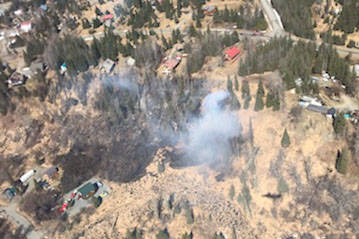Alaska’s Division of Forestry is currently monitoring what remains of a brush fire that occurred in Ninilchik on Saturday and burned 2.5 acres near a subdivision on the southern end of Oil Well Road.
The fire was first reported at 1:18 p.m. on Saturday, according to an update from the Division of Forestry via AKfireinfo.com. Ninilchik Emergency Services were the first to arrive on scene and evacuated two homes that were in immediate danger. The siding of one of the homes was partially damaged, but firefighters were able to contain the fire before any structures were destroyed or sustained significant damage.
Howard Kent, fire management officer for the Kenai/Kodiak Office of the Division of Forestry, said on Monday that four residences were evacuated while crews contained the fire. By 3:30 p.m. on Saturday everyone was able to return to their homes. As of Monday, Kent said the fire has been contained and controlled and is now being monitored by firefighters. By using a combination of water and hand tools to “mop up” what remains, crews will be scouring the ashes in the area for any potential hot spots where the fire could rekindle. Kent said that the fire was likely caused by human activity, but investigators are still working to determine the exact details.
Partly in response to Saturday’s fire, Alaska’s Department of Natural Resources issued a temporary suspension on Sunday of all burn permits on the peninsula. Kent attributed this suspension to three factors: current weather conditions, the high volume of dry fuels in the area and recent fire activity that has been human-caused. Kent said that since the official start of fire season on April 1, the Division of Forestry has responded to 12 fire events in the Kenai/Kodiak region — including one on Kodiak Island and one near the Soldotna Airport — and all 12 have been linked to human activity. Kent added that about 98% of all the fires that occur on the peninsula are caused by people, according to data from the Division of Forestry. In Alaska, anyone who starts a fire is financially responsible for suppression costs incurred by emergency responders as well as any damage to property or other people.
While dead or fallen spruce trees often make for quick kindling, Kent said that the main carrier of fire on the peninsula is grass, particularly at this time of the year. Last year’s grass died while buried under the snow all winter, and the long hours of sunlight dry it out quickly after it is uncovered.
With Alaska’s fire season already in full swing, Kent had a few reminders for anyone looking to burn, even if it’s just a simple campfire. Fire season in Alaska runs from April 1 to Aug. 31. Burn permits are required for all open burning with exceptions for small campfires, according to the Alaska Department of Natural Resources. Burn permits include comprehensive information on the best safety practices, the tools and supplies that should be on hand when burning and the different requirements for burn barrels versus pile burns.
“If you follow what’s on your burn permit to the letter, then you shouldn’t have any problems,” Kent said.
Kent noted that anyone with a burn permit is required to call the Division of Forestry’s burn permit hotline before burning to get approval for that day and to hear any updates on weather conditions or permit suspensions. Burn permits are not required for campfires and warming fires that are less than 3 square feet in size. The burn permit hotline is 907-260-4269.
Kent said that wind conditions are important to keep in mind when doing any kind of burning. If the wind is blowing at more than 10 mph, Kent recommended not burning and extinguishing any fires already started. Kent also noted that Saturday’s fire occurred with wind speeds as low as 3 to 5 mph — showing that it doesn’t take much for a fire to escape and spread.
Forestry.alaska.gov, NFPA.org and AKfireinfo.com are online resources that can provide more information about proper burning practices, and AKfireinfo.com provides minute-by-minute updates on fires that occur in the state. Kent said that the Division of Forestry’s Facebook page also posts regular updates about firefighting efforts in Alaska. Applications for burn permits are available at dnr.alaska.gov/burn, which also provides up-to-date information on any permit suspensions or burn bans, including the one currently in effect.

